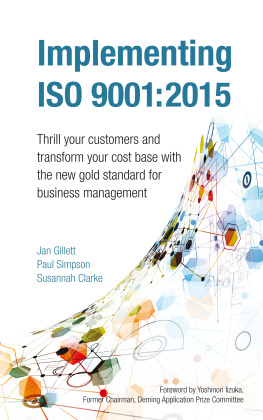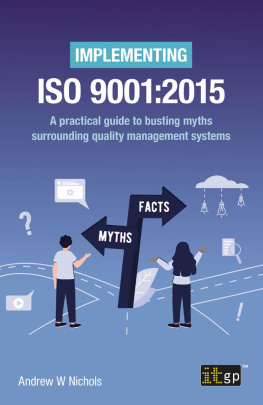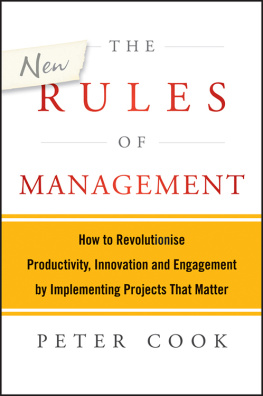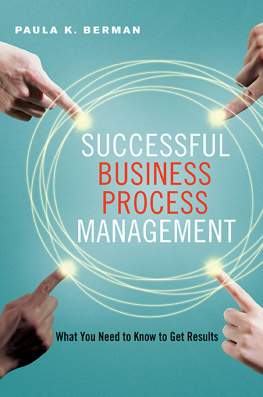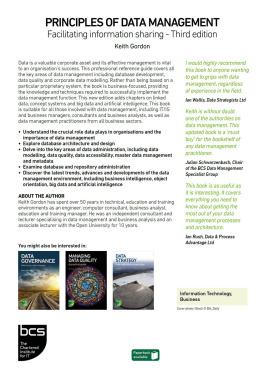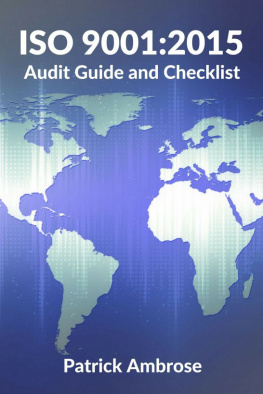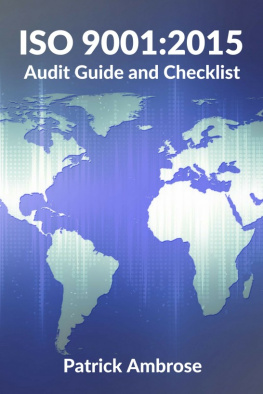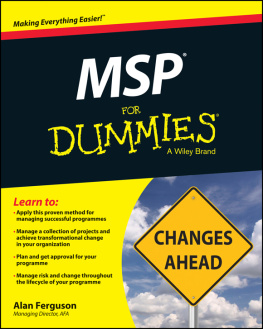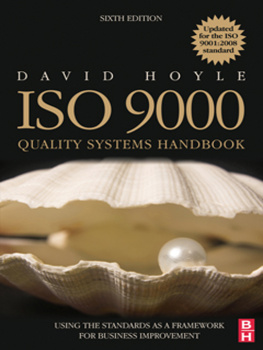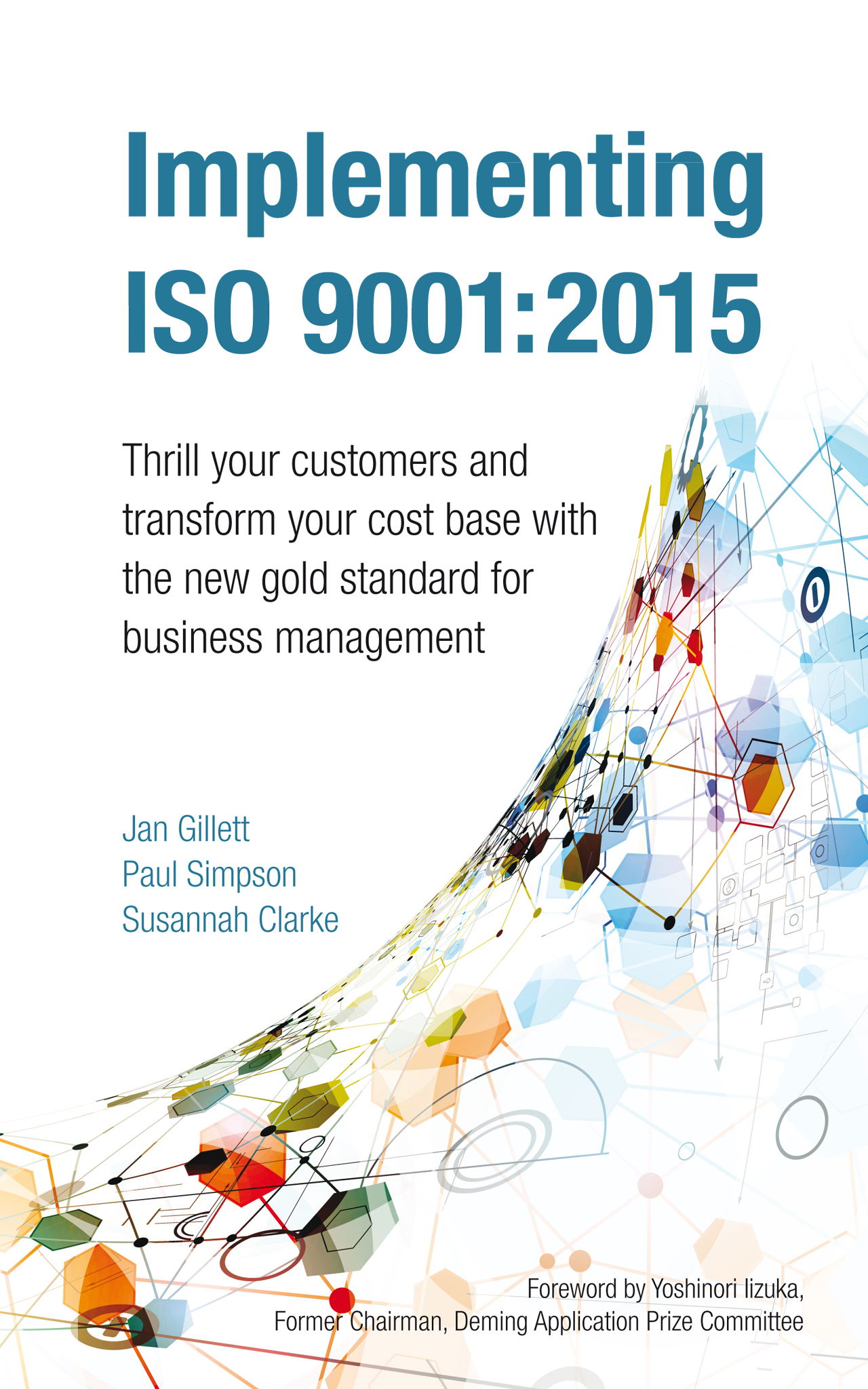ISO 9001 certification just got easier. All you need to do is put structure to logic, and PMI shows you how.
Adam Gade, Managing Partner at A&D Resources, Denmark; Former Vice President and Chief Information Officer, Maersk Line
Praise for Making Your Work Work
Making Your Work Work reveals great knowledge of as well as love and humbleness towards the topic, and offers priceless value to the reader. Am I surprised? Well thinking of the numerous books I have digested during the last decade, I actually thought that all there is to write had been written, but no, this book works! I therefore have no doubt the huge impact Implementing ISO 9001: 2015 will have for those who follow the methodology and thinking in achieving impressive results not only in terms of business improvement, but also in the pursuit and achievement of ISO 9001 registration in the future.
Heidi Kaas, CEO at Quatre Thinking Process Aps, Denmark
Making Your Work Work shows you how to manage your processes while simultaneously improving them. It doesnt offer a magic bullet and doesnt pretend to. What it does is demonstrate a tested, proven and scientific approach. Founded on Demings Plan Do Study Act cycle (PDSA), the book takes you through all the stages starting with study, through to what to do when the improvement is recognised and you are challenged to lead to the next level. Ive practised the basic tools and philosophy in this book for years in different industries, and I know that they work. The style is light but there is a lot of meat, and youll be referring back to it often.
Senior automotive industry engineer
At long last a business improvement book that goes back to the basics taught to us by Deming. Yes there are Lean, Six Sigma, TQM, etc., but they all come from one essential source and that is the work of Deming. Its great that in this book there is a real insight into how a manager can think through problems and implement genuine improvements by looking at organisations and departments through just four simple concepts.
Business improvement manager in UK Government Department
Basing itself on fundamental principles this book gives excellent insight into how to think and behave as a manager and leader who wants to focus on improving their workplace and services to customers. Written in an accessible style it combines the story of a manager learning and growing, alongside case studies and the application of theory into practice. It is certainly helping me develop my style and approach, and becoming a well-thumbed reference book as I help my organisation develop its thinking to see itself as a system and to continually improve and transform.
Howard Davies, Head of Continuous Improvement, Natural Resources Wales
This is for any business leader who wants to go beyond improvements and understand the underlying mechanics and systems that secures long-term effects. Having worked hard on the methods in the book Making Your Work Work , I keep it close as a reference guide. The fact of the matter is that the Deming system map is probably the single biggest epiphany I have had in business improvements and I keep coming back to that as a way to understand organisations.
Mads Bronden Wijngaard, Head of Business Transformation, Maersk Line, Denmark
Implementing
ISO 9001:2015
Thrill your customers and
transform your cost base with
the new gold standard for
business management
Jan Gillett
Paul Simpson
Susannah Clarke
Copyright Jan Gillett, Paul Simpson and Susannah Clarke, 2015
The right of Jan Gillett, Paul Simpson and Susannah Clarke to be identified as the authors of this book has been asserted in accordance with the Copyright, Designs and Patents Act 1988.
First published in 2015 by
Infinite Ideas Limited
36 St Giles
Oxford
OX1 3LD
United Kingdom
www.infideas.com
Implementing ISO 9001:2015 is an updated edition of Making Your Work Work, first published by Infinite Ideas in 2014.
All rights reserved. Except for the quotation of small passages for the purposes of criticism or review, no part of this publication may be reproduced, stored in a retrieval system or transmitted in any form or by any means, electronic, mechanical, photocopying, recording, scanning or otherwise, except under the terms of the Copyright, Designs and Patents Act 1988 or under the terms of a licence issued by the Copyright Licensing Agency Ltd, 90 Tottenham Court Road, London W1T 4LP, UK, without the permission in writing of the publisher. Requests to the publisher should be addressed to the Permissions Department, Infinite Ideas Limited, 36 St Giles, Oxford, OX1 3LD, UK, or faxed to +44 (0) 1865 514777.
A CIP catalogue record for this book is available from the British Library
ISBN 9781910902028
Brand and product names are trademarks or registered trademarks of their respective owners.
Typeset by KerryPress
Printed in Britain
Foreword
The revision to ISO 9001 is due to be published in September 2015. I am very pleased that my friends Jan Gillett and Paul Simpson and Jans colleague Susannah Clarke have co-authored a guidance book for the revision.
I am a believer in the Japanese way of Total Quality Management (TQM) and have been researching and teaching the theory of quality and its application to management at the University of Tokyo for many years. I have also been involved in development of the ISO 9000 series of standards since the mid-1980s and Jan and I have discussed quality enthusiastically for many years in a quality group, GQFW (Global Quality Future Workshop). Paul is also a colleague from our work in a task group revising the Quality Management Principles (QMP) in ISO/TC176, for which I was the leader and he was a core member.
The reason why I am so pleased that they have authored the book is not only because they are friends and colleagues, but also because the 2015 revision is intended to promote a purpose-oriented way for design of a Quality Management System (QMS). ISO 9001 has always been used for QMS certification. If we recognise that quality is the customers evaluation of the value provided through products and services, the management system model should be a critical model for business management.
The most important revision is, in fact, in clause 4 (context of the organisation), which requires organisations to design and establish their QMS autonomously. If they respond to changes clause by clause, the assessments in the certification process will focus on trivial details and come apart from their business. The problem could be a lack of consideration on objectives of QMS.
Regrettably in QMS certification, superficial conformance to ISO 9001 requirements is the norm. The three authors have a different view: they advocate that organisations should understand their QMS as a system and make the best use of it for business management. So, when they talk about system, they firstly think of the system as consisting of many elements and secondly that the whole system has objectives. By determining system objectives, identifying their elements, and understanding relations between these objectives and elements the system can be optimised.
The model for QMS in ISO 9001:2015 exactly follows this thought. The revised ISO 9001 is a model to design, establish, implement and improve the QMS as a system with the objective of customer satisfaction and consisting of processes. We should determine the QMS objectives, the capability required to achieve these objectives, install the capability in QMS elements, and continue to improve the QMS.

